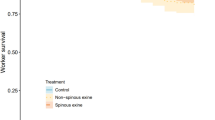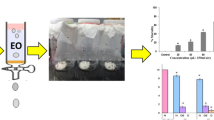Summary
Larvae of three moth species were compared with respect to strategies used to cope with secondary metabolites (allelochemicals) present in their diet.Syntomeida epilais is monophagous and accepted only oleander (which contains cardenolides, CG). CG were detected as stored products in the larvae and also in the faeces and exuviae. Pure CG (digoxin and gitoxin) which do not occur in oleander fed on oleander leaves were sequestered as the oleander CG.Syntomis mogadorensis is polyphagous: given a choice larvae avoided plants with a high load of allelochemicals. Upon shortage of preferred plants they ate a wide variety of plants which contain alkaloids, terpenes, or phenolics. Of these allelochemicals, alkaloids and CG were mainly recovered in the faeces and only minute fractions in the larvae.Creatonotos transiens larvae behaved similarly toSyntomis in terms of polyphagy and non-resorption. However, the larvae took up and stored pyrrolizidine alkaloids (PA) such as heliotrine selectively.Creatonotos is thus polyphagous (a generalist) but also a PA-specialist which exploits PA as defensive agents, as a morphogen for the male pheromone gland, and as a precursor for the male pheromone.
Similar content being viewed by others
Abbreviations
- CG :
-
cardiac glycosides
- IG :
-
iridoid glycosides
- PA :
-
pyrrolizidine alkaloids
- GLC :
-
gas liquid chromatography
- MS :
-
mass spectrometry
References
Alberts B, Bray D, Lewis J, Raff M, Roberts K, Watson D (1983) Molecular biology of the cell. Garland Publ New York
Barbosa P, Saunders JA, Kemper J, Trumbule R, Olechno J, Martinat P (1986) Plant allelochemicals and insect parasitoids. J Chem Ecol 12:1319–1328
Bell EA (1985) The biological significance of secondary metabolites in plants. In: Seawright AA, Hegarty MP, Jampes LF, Keeler RF (eds) Plant toxicology. Queensland Poisonous Plants Committ, Animal Res Inst Yeerongpilly, QU, Australia, pp 50–57
Bergomaz R, Boppré M (1986) A simple instant diet for rearing Arctiidae and other moths. J Lep Soc 40:131–137
Bernays EA (1982) The insect on the plant — a closer look. In: Visser JH, Minks AK (eds) Proc. 5th int. Symp. Insect-plant relationship. Pudoc, Wageningen, Netherlands, pp 1–17
Bernays EA, Simpson SJ (1982) Control of food intake. Adv Insect Physiol 16:59–118
Boppré M (1986) Insects pharmacophagously utilizing defensive plant chemicals (pyrrolizidine alkaloids). Naturwissenschaften 73:17–26
Boppré M (1990) Lepidoptera and pyrrolizidine alkaloids: exemplification of complexity in chemical ecology. J Chem Ecol 16:165–185
Boppré M, Schneider D (1985) Pyrrolizidine alkaloids quantitatively regulate both scent organ morphogenesis and pheromone biosynthesis in maleCreatonotos moths (Lepidoptera: Arctiidae). J Comp Physiol A 157:569–577
Boppré M, Schneider D (1989) The biology ofCreatonotos (Lepidoptera: Arctiidae) with special reference to the androconial system. Zool J Linnean Soc 96:339–356
Brattsten LB (1988) Enzymatic adaptation in leaf-feeding insects to host-plant allelochemicals. J Chem Ecol 14:1919–1939
Brower LP (1984) Chemical defense in butterflies. In: Vane-Wright RI, Ackery PR (eds) The biology of butterflies. Academic Press, London, pp 109–134
Brower LP, Glazier SC (1975) Localization of heart poisons in the monarch butterfly. Science 188:19–25
Brown KS Jr (1984a) Adult-obtained pyrrolizidine alkaloids defend ithomiine butterflies against a spider predator. Nature 309:707–709
Brown KS Jr (1984b) Chemical ecology of dehydropyrrolizidine alkaloids in adult ithomiiae (Lepidoptera: Nymphalidae). Rev Brasil Biol 44:435–460
Chapman RF (1974) The chemical inhibition of feeding by phytophagous insect: a review. Bull ent Res 64:339–363
Chapman RF (1982) Chemoreception: the significance of sensillum numbers. Adv Insect Physiol 16:247–356
Chapman RF, Bernays EA (1989) Insect behavior at the leaf surface and learning as aspects of host plant selection. Experientia 45:215–222
Cohen JA, Brower LP (1983) Cardenolide sequestration by the dogbane tiger moth (Cycnia tenera; Arctiidae). J Chem Ecol 9:521–531
Covell CV Jr (1984) A field guide to the moths of eastern North America. Houghton Mifflin Comp, Boston
Deus-Neumann B, Zenk MH (1986) Accumulation of alkaloids in vacuoles does not involve an ion-trap mechanism. Planta 167:44–53
Duffey SS, Blum MS, Isman MB, Scudder GGE (1978) Cardiac glycosides: a physical system for their sequestration by the milkweed bug. J Insect Physiol 24:639–645
Dussourd DE, Ubik K, Harvis K, Resch JF, Meinwald J, Eisner T (1988) Biparental defence endowment of eggs with acquired plant alkaloid in the mothUtetheisa ornatrix. Proc Natl Acad Sci USA 85:5992–5996
Egelhaaf A, Cölln K, Schmitz B, Buck M, Wink M, Schneider D (1990) Organ specific storage of dietary pyrrolizidine alkaloids in the arctiid mothCreatonotos transiens. Z Naturforsch 45c:172–177
Ehmke A, Borstel K von, Hartmann T (1988) Alkaloid N-oxides as transport and vacuolar storage compounds of pyrrolizidine alkaloids inSenecio vulgaris L. Planta 176:83–90
Eisner T, Meinwald J (1987) Alkaloid-derived pheromones and sexual selection in Lepidoptera. In: Prestwitch GD, Blomquist GJ (eds) Pheromone biochemistry. Academic Press, Orlando FL, pp 251–269
Franke A, Rimpler H, Schneider D (1987) Iridioid glycosides in the butterflyEuphydryas cynthia (Lepidoptera, Nymphalidae). Phytochemistry 26:103–106
Greene E (1989) A diet-induced developmental polymorphism in a caterpillar. Science 243:643–646
Harborne JB (1982) Introduction to ecological biochemistry. 2nd edtn, Adademic Press, London/New York
Lewin DA (1976) The chemical defences of plants to pathogens and herbivores. Ann Rev Ecol Syst 7:121–159
Matile P (1984) Das toxische Kompartiment der Pflanzenzelle. Naturwissenschaften 71:18–24
Mende P, Wink M (1987) Uptake of the quinolizidine alkaloid lupanine by protoplasts and isolated vacuoles of suspension-culturedLupinus polyphyllus cells. Diffusion or carrier-mediated transport? J Plant Physiol 129:229–242
Nickisch-Rosenegk E von, Detzel A, Schneider D, Wink M (1990) Carrier-mediated uptake of digoxin by larvae of the cardenolide sequestering mothSyntomeida epilais. Naturwissenschaften (in press)
Nickisch-Rosenegk E von, Schneider D, Wink M (1990) Time course of PA processing in the pyrrolizidine alkaloid exploiting mothCreatonotos transiens. Z. f. Naturforsch. (in press)
Reichstein T, Euw J von, Parsons JA, Rothschild M (1968) Heart poisons in the monarch butterfly. Science 161:861–866
Roeske CN, Seiber J, Brower LP, Mofitt CM (1976) Milkweed cardenolides and their comparative processing by monarch butterflies (Danaus plexippus). Rec Adv Phytochem 10:93–167
Rosenthal G, Janzen D (eds) (1979) Herbivores: their interaction with secondary plant metabolites. Academic Press, London New York
Rothschild M (1972) Secondary plant substances and warning colouration in insects. In: Emden HF van (ed) Insect plant relationship. Blackwells Scient Publ, Oxford, pp 59–83
Rothschild M, Euw J von, Reichstein T (1973) Cardiac glycosides (heart poisons) in the polka-dot mothSyntomeida epilais Walk. (Ctenuchidae: Lep.) with some observations on the toxic qualities ofAmata (=Syntomis) phegea (L.). Proc R Soc Lond B 183:227–247
Rothschild M, Euw J von, Reichstein T, Smith DAS, Pierre J (1975) Cardenolide storage inDanaus chrysippus (L.) with additional notes onD. plexippus (L.). Proc R Soc Lond B 190:1–31
Rothschild M, Reichstein T (1976) Some problems associated with the storage of cardiac glycosides by insects. Nova Acta Leopoldina Suppl. 7:507–550
Rougeot PC, Viette P (1983) Die Nachtfalter Europas und Nordafrikas. I: Schwärmer und Spinner. E. Bauer, Keltern
Schmitz B, Buck M, Egelhaaf A, Schneider D (1989) Ecdysone and a dietary alkaloid interact in the development of the pheromone gland of a male moth (Creatonotos, Lepidoptera: Arctiidae). Roux's Arch Dev Biol 198:1–7
Schneider D (1987a) The strange fate of pyrrolizidine alkaloids. In: Chapman RF, Bernays EA, Stoffolano JG (eds) Perspectives in chemoreception behaviour. Springer, Berlin Heidelberg New York, pp 123–142
Schneider D (1987b) Plant recognition by insects: a challenge for neuro-ethological research. In: Labeyrie V, Fabres G, Lachaise D (eds) Insects-Plants. Dr W Junk Publisher, Dordrecht, pp 117–123
Schneider D, Boppré M, Zweig J, Horsley SB, Bell TW, Meinwald J, Hansen K, Diehl ED (1982) Scent organ development inCreatonotos moths: regulation by pyrrolizidine alkaloids. Science 215:1264–1265
Scudder GGE, Meridith J (1982) The permeability of the midgut of three insects to cardiac glycosides. J Insect Physiol 28:689–694
Scudder GGE, Moore LV, Isman MB (1986) Sequestration of cardenolides inOncopeltus fasciatus: Morphological and physiological adaptations. J Chem Ecol 12:1171–1187
Self LS, Guthrie FE, Hodgson E (1964) Adaptations of tobacco hornworms to the ingestion of nicotine. J Insect Physiol 10:907–914
Swain T (1977) Secondary compounds as protective agents. Ann Rev Plant Physiol 28:479–501
Thorpe KW, Barbosa P (1986) Effects of consumption of high and low nicotine tobacco byManduca sexta (Lepidoptera: Sphingidae) on survival of gregarious endoparasitoidCotesia congregata (Hymenoptera: Braconidae). J Chem Ecol 12:1329–1337
Wink M (1987) Physiology of the accumulation of secondary metabolites with special references to alkaloids. In: Constabel F, Vasil IK (eds) Cell culture and somatic cell genetics of plants, vol 4. Academic Press, London New York, pp 17–42
Wink M (1988) Plant breeding: importance of plant secondary metabolites for protection against pathogens and herbivores. Theor Appl Genet 75:225–233
Wink M, Nickisch-Rosenegk E von, Schneider D (1990) Processing of pyrrolizidine alkaloids and cardenolides in three mothsSyntomis mogadorensis, Syntomeida epilais andCreatonotos transiens. Proc. 7th Interntl. Sympos. Insect-Plant Relations. Budapest (in press)
Wink M, Schneider D (1988) Carrier-mediated uptake of pyrrolizidine alkaloids in larvae of the aposematic and alkaloid-exploiting mothCreatonotos. Naturwissenschaften 75:524–525
Wink M, Witte L, Hartmann T, Theuring C, Volz V (1983) Accumulation of quinolizidine alkaloids in plants and cell suspension cultures: GeneraLupinus, Cytisus, Baptisia, Genista, Laburnum, andSophora. Planta Med 48:253–257
Wink M, Witte L (1987) Alkaloids in stem roots ofNicotiana tabacum andSpartium junceum transformed byAgrobacterium rhizogenes. Z Naturforsch 42c:69–72
Wunderer H, Hansen K, Bell TW, Schneider D, Meinwald J (1986) Sex pheromones of two Asian moths (Creatonotos transiens, C. gangis; Lepidoptera-Arctiidae): behavior, morphology, chemistry and electrophysiology. Exp Biol 46:11–27
Author information
Authors and Affiliations
Rights and permissions
About this article
Cite this article
Wink, M., Schneider, D. Fate of plant-derived secondary metabolites in three moth species (Syntomis mogadorensis, Syntomeida epilais, andCreatonotos transiens). J Comp Physiol B 160, 389–400 (1990). https://doi.org/10.1007/BF01075670
Accepted:
Issue Date:
DOI: https://doi.org/10.1007/BF01075670




